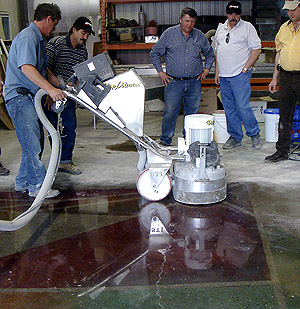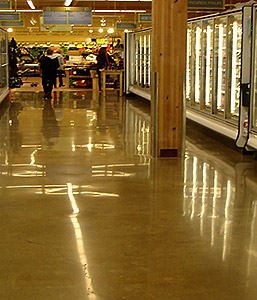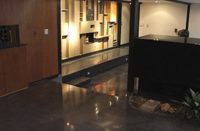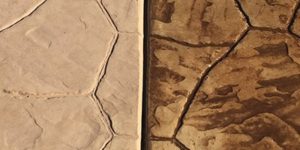
Polished concrete is now accepted as a standard flooring option, especially in the commercial, education, hospitality and retail sectors.
Two common elements of our industry are that 1) we think we know it all and 2) we don’t learn from our mistakes and shortcuts. Why is it that our industry, polished concrete with or without color, seems to have such an extended learning curve?
For the sake of argument, let’s say that the polished concrete industry, as we know it today, started 10 years ago. Now when you think of a decade, you could naturally assume that the learning curve should be over, but it is not. In fact, with the quantum growth of the industry in the past 18 to 36 months, and the influx of applicators from many other disciplines, it has gotten worse. Whereas polished concrete used to be the exception, or primarily in “big boxes,” it is now accepted as a standard flooring option, especially in the commercial, education, hospitality and retail sectors.
If provided the opportunity, when should you insert yourself in the project? Is it at the planning stage? Should you be concerned with additives, curing methods and flatness specs? If you are preparing to provide your customer with a densified, polished floor, with or without color, the answer must be a resounding “Yes!”
Polished concrete, with or without color, always depends on the ability of the chemicals to penetrate the concrete, either to interact with the calcium hydroxide created during hydration or to surround the concrete with color. Prior to these types of chemical applications, the concern when applying a floor coating or covering was whether or not the adhesives or coatings would stick, or whether moisture would be a problem. In our industry that is not the case.

Whom do we have to educate about it?
Yourself, the applicator. If the applicator, the one who requires specifications to be written correctly, does not understand his own needs, then he shouldn’t be in the industry. Lack of knowledge and willingness to become educated too often translates into frustration and costly failures.
The architect or specifier. The architect is not only concerned with the basic performance of a product, but he or she also must know how it interacts with every other aspect of the design/build function of the project. And today he or she is more often than not focusing on LEED, green and sustainability requirements.
The general contractor, ready-mix provider, flatwork contractor and other subcontractors. Why should they care? Well, mix designs, additives, curing methods and flatness requirements all can affect the costing, supervision and methods utilized on any given project, and the successful results on the job as well. Keep in mind, you as the applicator will have your ability to deliver results and profits directly affected by the partnerships you create with these companies.
What are some of the areas you must focus on when working with polished concrete, and why? How can specifications affect your performance in a negative manner? Remembering that we talked about working with “penetrating” products, not topical ones, we must be concerned with the following steps, in the following order:
- What additives are being utilized on the project? What is being used to aid curing? What about release agents for tilt-ups?
- How is the floor being finished? As for flatness requirements, what are the expectations and why?
- What is the color of your concrete mix, and why should that matter to you?
- Aggregate or cream — what does the customer expect to see at the end?
Everything being discussed here will also affect the restoration of existing slabs. Then, it is even more important than with new concrete to ask the questions, and most definitely, perform tests before committing your firm and your costing.
The problem with additives
How can additives stop you from completing your work? It is very simple: They can act as bond barriers or breakers that will stop your chemical from penetrating and reacting or adhering. Two main additives or barriers are UV-dissipative cures and tilt-wall release agents. When UV-dissipative cures were created, they were done so with the need to dissipate enough to allow the application and adhesion of a topical product, not a penetrating one. UV-dissipative cures are expected to “go away” based on exposure to UV rays and wear traffic during construction. Generally the time frame provided is 7 to 9 weeks, but, unfortunately, they are rarely applied where they actually will be exposed to UV rays at all.
Tilt-wall release agents, while not expected to dissipate, can be removed using certain cleaners and strippers. Again though, the problem is how much product remains below the surface, and whether it will create an impenetrable barrier to your products.
Be prepared to go as low as 40 grit in metal diamonds to fully remove either product, which then affects your costing and the floor appearance.
If your customer is expecting a cream finish, than neither of these products can be used.
Pick a look
Floor flatness is inherently important when it comes to what appearance the customer expects, how your equipment can provide that appearance, how the floor will be used, and whether the floor is going to be colored. Does your customer want cream or fines or aggregate showing? Do they want consistency of cream or fines or aggregate? Or are they agreeable to a mixture of appearances?
Equipment capabilities vary greatly in width, weight, power requirements and head-float capability.
You have three options for providing a consistent look:
The customer does not require a truly flat floor, only a polished floor, but they want a consistent cream appearance. In this case you need to have equipment with heads that float to allow for following the contours of the floor, and you’ll primarily use resin diamonds.
Your customer does not care if the floor is all cream, fines or aggregate — they just want consistency. This will be achieved with large, heavy plate machines that can easily grind through a high spot but cannot float with the floor’s waviness, utilizing metal matrix diamonds to literally grind the floor until uniform flatness is achieved, then following with resin matrixes. A floor like this might be specified for either appearance or function, such as a high-cube warehouse.
The last method is through proper specifications based on the F(f) and F(l) of the floor. These terms relate to Face Companies designations for flatness and levelness of a slab, which are achieved at the time of finishing. By providing the applicator with a flat floor to begin with, the type and number of diamond steps required are reduced, along with the ability to achieve a flat floor with a consistent cream appearance.
The color of the concrete mix will affect the final appearance in two ways. When just densifying, the color of the mix is roughly what the end product will show for color. This can vary by regions or by cement designation, whether grey or white. Also, when coloring concrete with either dyes or acid stains, everyone must be aware these are translucent coloring products whose final color appearance will be affected by the mix color. The darker the mix design, the more the colors are muted and absorbed, while the lighter the slab, the more enhanced and brilliant the colors will be. Remember that concrete, when finished, will have natural variations, and any variations that exist prior to dyeing or acid staining will show in the final product.
Aggregate or cream — what does the customer expect? Education though job walk-throughs and project photographs is an important visual assist in the education curve. Make sure that what your customer wants is what you and your equipment can deliver.
Stain shields: Yes or no?
Why is the application of a stain shield recommended by acid stain and dye manufacturers? Too often everyone from the specifier through to the applicator is not fully aware of the inner workings of a chemical densifier, whether it is sodium, potassium or lithium-based. A chemical densifier delivers increased abrasion resistance, which protects the wear surface, especially for colors, and increased repellency to certain, but not all, liquids. What is not taught and talked about often enough is that although the increased abrasion resistance delivers almost immediate results, the repellency can take up to 6 to 8 months to fully deliver. Repellency is only achieved as the concrete continues to create an inner structure that is denser and tighter. Remember that the concrete slab is porous. Actually, it is more porous after you have ground than at the end of your hard steel-trowel finishing that consolidates the surface.
So for your customer’s sake, along with yours, a stain repellant is important to protect your work against oil and water-based spills. Keep in mind that a repellent is only meant to extend the window of opportunity to clean a potential stain. To fully protect the floor would require a 100-percent topical sealer and this defeats the maintenance benefits of a polished floor. Also, the floor is still concrete and can be etched by strong acids.
If you can’t deliver — don’t accept the project! How do you know if you can deliver?
Always perform a test. Do the test on the actual job site before beginning the project.
Perform every single step of the test. Don’t allow the general contractor to force you to rush and start before you’re ready or before the concrete slab is ready. The generally recognized hydration time is 28 days. Know what can be affected by going too early. Lower strength, softer concrete and excessive water can all affect your final results.
Have a written “sign-off” by the owner or their authorized contact as written in the contract.
You have rights as the subcontractor, and the general contractor and owners have rights — these will be better met through education and respect for each other’s requirements on the job. The better, and sooner, a general contractor, or for that matter, another subcontractor, knows your needs, the better the job will flow, the faster you’ll get a sign-off and the quicker you’ll get paid.
















